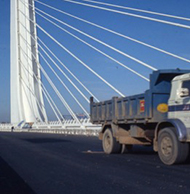 ESR10: Assessment of bridge condition and safety based on measured vibration level
ESR10: Assessment of bridge condition and safety based on measured vibration level
- Host: Universitat Politècnica de Catalunya (UPC)
- Address: School of Civil Engineering, c/Jordi Girona 1-3. Campus Nord. Modul C1, 08034 Barcelona, Spain.
- Main Supervisor: Prof. Joan Ramon Casas
- Fellow: JJ Moughty
Bridge condition is commonly related to the dynamic parameters of the bridge (natural frequencies, mode shapes and damping). However, environmental conditions and concrete age have been identified as main drawbacks of using dynamic parameters for bridge inspection and health monitoring. In addition, as the changes in natural frequency and modal amplitude are related to changes in the stiffness and mass, the changes of these parameters can give only information on the condition of the structures, but not on the actual safety. Some authors have correlated the degree of damage in actual buildings with the vibration intensities deduced from accelerations measured close to the damaged regions.
TRUSS will extend this research by relating the level of vibration due to normal traffic action to the condition index and safety of the tested bridges. For the group of bridges selected, a visual inspection will be carried out to obtain a condition index based on standard methods. Also, based on the available information of the bridges (dimensions, materials, etc) the safety to Ultimate Limit States (bending and fatigue) will be computed and measured in terms of the reliability index. Afterwards, a dynamic test will be performed aiming to obtain the vibration intensity for different vehicles at different speeds and also for the normal traffic in the bridge. Several definitions of vibration level (vibrars, peak-to-peak acceleration, etc) will be checked and compared to the condition and reliability indices and the correlation between them will be obtained.
Finally, a set of plots relating the measured vibration level with the condition and reliability index will be proposed for several types of bridges (simply supported, continuous).
In addition, the use of existing data-bases with available dynamic records for tested bridges will be investigated in order to obtain a large group of bridges for the study.
You can follow blog and publications by ESR10 below.



